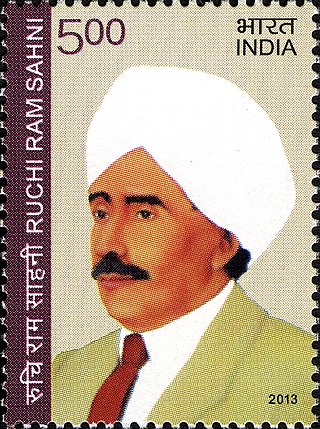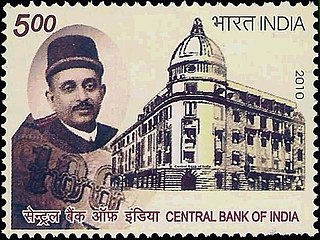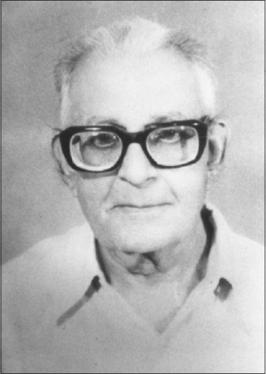Related Research Articles

Palaniappan Chidambaram, better known as P. Chidambaram, is an Indian politician and lawyer who currently serves as Member of Parliament, Rajya Sabha. He served as the Chairman of the Parliamentary Standing Committee on Home Affairs from 2017 to 2018.

The University of Allahabad is a collegiate central university located in Allahabad, Uttar Pradesh, India. It was established on 23 September 1887 by an act of Parliament and is recognised as an Institute of National Importance (INI). It is one of the oldest modern universities in India. Its origins lie in the Muir Central College, named after Lt. Governor of North-Western Provinces Sir William Muir in 1876, who suggested the idea of a Central University at Allahabad, which later evolved to the present university. It is known as the "Oxford of the East". Its Central University status was re-established through the University of Allahabad Act 2005 by the Parliament of India.

Lala Lajpat Rai was an Indian author, freedom fighter, and politician. He played a vital role in the Indian Independence movement. He was popularly known as Punjab Kesari. He is also known as 'Punjab da Sher' which literally means the 'Lion of Punjab'. He was one of the three members of the Lal Bal Pal trimurti. He was also associated with management activities of Punjab National Bank in early years and Lakshmi Insurance Company in their early stages in 1894. He died of a severe head injury after 18 days of trauma injuries during a baton charge by police in Lahore, when he led a peaceful protest march against the all-British Simon Commission Indian constitutional reforms.

Vasant Panchami, also called Saraswati Puja in honor of the Hindu goddess Saraswati, is a festival that marks the preparation for the arrival of spring. The festival is celebrated in Indian religions in different ways depending on the region. Vasant Panchami also marks the start of preparation for Holika and Holi, which take place forty days later. The Vasant Utsava (festival) on Panchami is celebrated forty days before spring, because any season's transition period is 40 days, and after that, the season comes into full bloom.

Diwan Bahadur Sir Satappa Ramanatha Muttaiya Annamalai Chettiar, Raja of ChettinadKCSI was an Indian industrialist, banker, educationist and philanthropist from Tamil Nadu. He is the founder of Annamalai University in Chidambaram and one of the founders of Indian Bank, along with his brother S. Rm. M. Ramaswami Chettiar.

Rai Bahadur Sir Ganga Ram was an Indian civil engineer and architect. His extensive contributions to the urban fabric of Lahore, then in colonial India and now in modern Pakistan, caused Khaled Ahmed to describe him as "the father of modern Lahore".

Habib Tanvir was one of the most popular Indian Urdu, Hindi playwrights, a theatre director, poet and actor. He was the writer of plays such as, Agra Bazar (1954) and Charandas Chor (1975). A pioneer in Urdu and Hindi theatre, he was most known for his work with Chhattisgarhi tribals, at the Naya Theatre, a theatre company he founded in 1959 in Bhopal. He went on to include indigenous performance forms such as nacha, to create not only a new theatrical language, but also milestones such as Charandas Chor, Gaon ka Naam Sasural, Mor Naam Damad and Kamdeo ka Apna Basant Ritu ka Sapna.
Mulki Sunder Ram Shetty (1915-1981) was an Indian Banker. He was associated with Vijaya Bank since 1946 and joined the board of directors of the bank as Chairman from 1962, became the Hon. Chairman from 1962 to 1969 resulting in growth of Vijaya bank. and then remained as full-time Chairman till 1978. Under the Chairmanship of Shri Mulki Sunder Ram Shetty, Vijaya Bank steadily grew into a large All India Bank with nine smaller banks merging with it during 1963-1968. During the year 1965, the Bank registered its own logo.

Raja Sir Muttaiya Annamalai Muthiah Chettiar was an Indian banker, politician, philanthropist, socialite and cultural activist who served as Mayor of Madras city (1933) and Minister of Excise and Education (1936–37) in the provincial government of Madras Presidency. He was holder of the hereditary title Kumar-rajah (1929–48) and later, Raja of Chettinad (1948–84).

Ruchi Ram Sahni was an Indian scientist and educationist active during the pre-partition era in Punjab. A pioneer meteorologist and physicist, he was the father of renowned paleobotanist Birbal Sahni.

Sir Sorabji Nusserwanji Pochkhanawala was an Indian Parsi banker and one of the founders of the Central Bank of India.
Kandathil Mammen Cherian was an Indian media person and former chief-editor of Malayala Manorama, the Malayalam daily, ranked the first in Malayalam, the fourth in India. and the eleventh in the World, in terms of circulation. He is a recipient of Padma Bhushan and Padma Shri, the third and fourth-highest Indian civilian awards.
Laxman Mahadeo Chitale, (1892-1960) was an Indian architect, author and one of the first Indian associates of the Royal Institute of British Architects. He was the architect of several landmark buildings in India such as the Life Insurance Corporation of India building, Chennai, Ram Mohan Palace, Kochi which was once the seat of the High Court of Kerala, Subramania Bharati Monument, Ettayapuram, Central Leather Research Institute (CLRI), Adyar and the Reserve Bank of India building, Nagpur. The Government of India honoured him in 1957, with the award of Padma Shri, the fourth highest Indian civilian award for his services to the nation.
Raj Kumar Talwar (1922–2002) was an Indian business executive. He served as chairman of State Bank of India who was sacked by the Indira Gandhi government in the emergency in 1976 for refusing to grant loans to people favoured by the government. As no provision in the SBI Act allowed them to terminate the chairman, the Act had was amended to sack him.

Anantharamakrishnan Sivasailam was an Indian industrialist, educationist, philanthropist and a former chairman and managing director of Amalgamations Group of Industries, a ₹ 70 billion conglomerate hosting a workforce of over 12,000. He headed the business family which was listed by Forbes as the 37th richest in India in 2015, with a net worth of US$ 2.5 billion. He was the president of the Society of Indian Automobile Manufacturers and ASSOCHAM and held the office of the Sheriff of Madras during 1969–1970. The Government of India awarded him the fourth highest civilian honour of the Padma Shri, in 2007, for his contributions to Indian industry.
The 1921 Birthday Honours were appointments by King George V to various orders and honours to reward and highlight good works by citizens of the British Empire. The appointments were made to celebrate the official birthday of the King, and were published on 3 and 4 June 1921.

Baldev Singh was an Indian neurologist. He was best known for collaborative works with neurologists Jacob Chandy, Balasubramaniam Ramamurthi and S. T. Narasimhan and together they have been credited to be pioneers in development of epilepsy surgery in India. They also helped in establishing the Neurological Society of India in 1951 at Madras. After training in the United States of America, he returned to India and established himself at Delhi. He was presented with the Padma Bhushan in 1972 for his contributions in the field of medicine.

Lala Harkishen Lal was an Indian industrialist, entrepreneur and politician. He was a co-founder of Punjab National Bank, and founder of factories and banks Punjab Cotton Press Company Ltd., the People's Bank of India Ltd., Amritsar Bank Ltd.; the Kanpur Flour Mills Ltd. in pre-independent India. He was also instrumental in the establishment of Indian Associated Chamber of Commerce, the precursor, of the formation of the Federation of Indian Chambers of Commerce & Industry. As politician, he served as the Minister of Agriculture of the government of Punjab Province between 1920 and 1923.
Biyyathil Mohyuddin Kutty was a Pakistani journalist, public servant, politician, peace activist, trade unionist, and liberal intellectual who worked for the betterment of India–Pakistan relations. Born to a family of peasants and landowners in Chilavil–Ponmundam village of Tirur, Malabar District, Madras Presidency, Kutty was influenced by communism at an early age and joined the student faction of the Communist Party of India in the 1940s. He attended Mohammedan College in Madras from 1945 to 1949 to please his father and there he joined the Muslim Students Federation. He left the college right after the final examinations and did not wait to receive his certificates. At the age of 19 he left his family and India for Pakistan, citing his "love for geography" as the motivation behind his move.

Amar Chand Joshi, also known as A. C. Joshi, was an Indian botanist and academic administrator, who served as the Vice-Chancellor of Panjab University, Chandigarh, India; and the Vice-Chancellor of Banaras Hindu University, Varanasi, India. The standard author abbreviation Joshi is used to indicate this person as the author when citing a botanical name. Joshi co authored a book titled Lahore District Flora with Shiv Ram Kashyap. It was published by Punjab University in 1936.